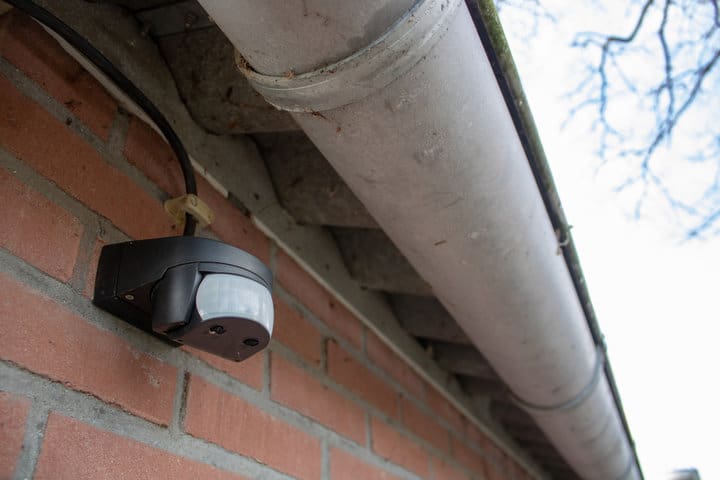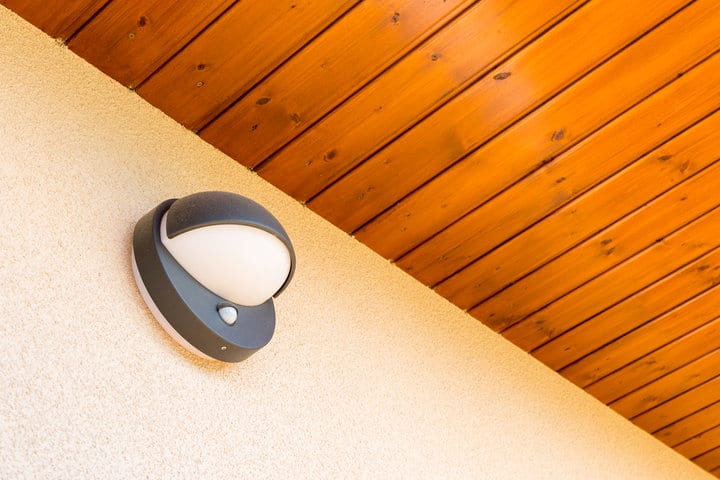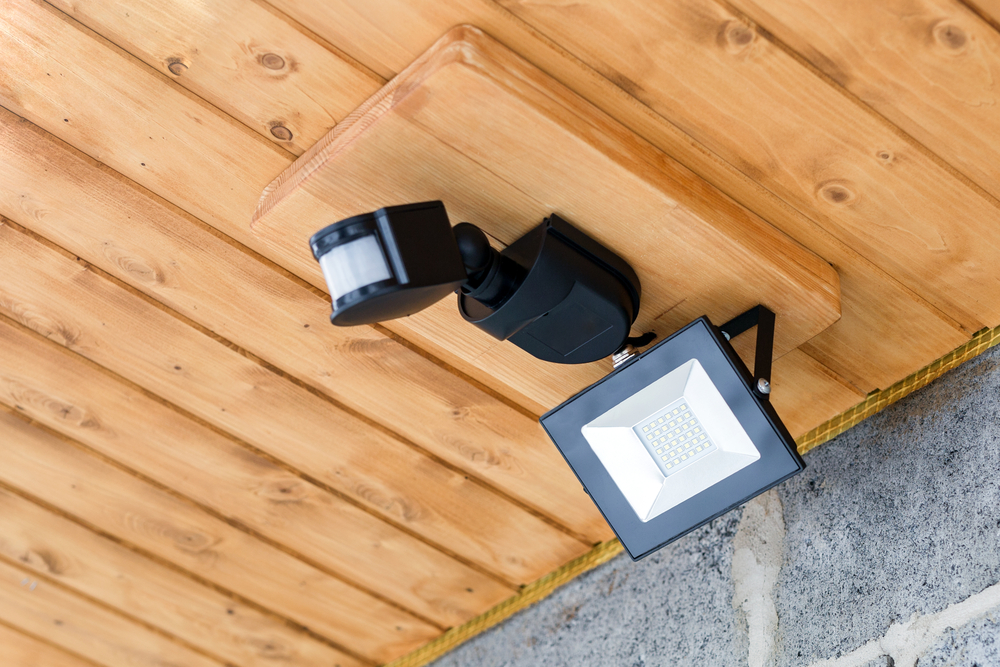Motion sensor lights have a lot of benefits. First, they only turn the lights on when you need them.
For example, when you’re approaching your home or entering a room.
Or when there’s someone else on your property that you want to spook into hopefully leaving, whether they’re a human or an animal.
Not only do you get the safety of the lights being switched on, but they turn off automatically too.
So you aren’t annoying neighbors by having lights switched on when they aren’t needed.
What about energy savings?
Does having motion sensor lights significantly impact your electricity bills too?
Motion sensor lights save electricity compared to leaving the light switched on for longer. PIR sensors use minimal power – on average, just 0.1 watts when they aren’t triggered. The total money saved on bills won’t be huge, especially with LED lights, but it will save a small amount.
Let’s explore this in a little more detail by looking at:
- Whether motion sensor lights are energy efficient
- How much power a PIR sensor uses
- How much electricity a motion sensor light will save
Are Motion Sensor Lights Energy-Efficient?
When considering whether a motion sensor light is energy efficient, you need to split it into two questions.
Is the fact that it’s triggered by a motion sensor efficient? Is the light itself efficient?
The first question is easy to answer.
All you need to know is whether a motion sensor uses more or less power than the light itself.
If it does, it is energy efficient – you can let the sensor run, and it will use less power than leaving the light on.
So does a motion sensor use less power than light does? Absolutely.
Even the most efficient lights use much more power than a PIR sensor.
I’ll explain exactly how much further down the page.
The second question – the light efficiency – can be answered based on the bulb type.
If it’s an LED light, then yes, it can be called energy efficient because compared to other types of bulbs, LEDs use a lot less power.
Compact fluorescent bulbs are the second-most efficient type of bulb.
However, they aren’t used for motion sensor lights – they take too long to switch on and reach full brightness.
While halogen lights are more efficient than old incandescent ones, you couldn’t call them efficient when LEDs are so widely available now.
So, are motion sensor lights energy efficient?
Yes, if they’re LED lights. And any motion sensor light is more efficient than a light being left switched on.
How Much Power Does A PIR Sensor Use?

PIR sensors aren’t exactly the same, but the good news is that broadly they all use a very low amount of power.
How much will vary depending on whether the motion sensor is in standby mode or triggered by motion.
Older sensors might have used around 1 watt of power when in standby mode, but some modern ones use a lot less.
This information isn’t often listed in a sensor’s manual or product spec, but this one says that it uses just 40 microamperes in standby mode – the equivalent of around 0.004 watts.
When triggered, it uses 10x that amount, but that’s still less than 0.1 watts. So it’s a fractional amount.
Again, older sensors may use more when triggered, but even then, it’s likely no more than 5-8 watts, and that’s only when the light is switched on.
So how much power a PIR sensor uses will depend on how often the sensor is triggered.
If it’s an indoor light, you might spend around 3 hours a day in a room along with 21 hours of passive consumption.
However, if it’s an outdoor light, working on a dusk to dawn sensor, it only triggers at night, then it might only be triggered for an hour at most.
Likely even less if you don’t tend to have animals setting it off every now and then.
The actual consumption of just the PIR sensor alone will likely be less than 5 watts a day and is often a lot less, depending on how often the sensor is being triggered and how modern the sensor is.
How Much Electricity Do Motion Sensor Lights Save?

Working out exactly how much electricity a motion sensor light saves isn’t straightforward.
As I’ve said, sensors don’t all consume the same amount of power. It depends on where the sensor is located, how modern it is, and how often it’s triggered.
However, we can work with some examples. Let’s start with indoor light, assuming the living room.
For this example, the room is used from 6pm until 11pm, but you keep leaving it to cook dinner or head to the bathroom.
Of the 5 hours, you spend 3 hours in the room.
And I’m going to compare an LED and a halogen light bulb as options that would give a similar level of lumens.
So that’s a 7-watt LED and a 40-watt halogen.
Without a motion sensor, the LED bulb uses 35 watt-hours of power, while the halogen bulb uses 200 watt-hours.
When the light is off, no power is used.
With a motion sensor, the bulbs are only on for 3 hours – the LED uses 21 watt-hours and the halogen 120 watt-hours.
Let’s use that sensor above, which uses 0.004 watts when it isn’t triggered for 21 hours a day, for a total of 0.084 watts, and 0.04 watts when it is triggered for 3 hours a day, for a total of 0.12 watts.
Combined, the sensor uses 0.204 watts per day.
| Bulb/sensor combo | Watt-hours used when ‘on’ | Watt-hours used when ‘off’ | Total watt-hours per day | Total watt-hours per year |
|---|---|---|---|---|
| LED bulb, no sensor | 35 watt-hours | 0 watt-hours | 35 watt-hours | 12,775 watt-hours |
| LED bulb, motion sensor | 21.12 watt-hours (21W LED bulb, 0.12 W motion sensor) | 0.084 watt-hours | 21.2 watt-hours | 7,738 watt-hours |
| Halogen bulb, no sensor | 200 watt hours | 0 watt-hours | 200 watt-hours | 73,000 watt-hours |
| Halogen bulb, motion sensor | 120.12 watt hours (120 W halogen bulb, 0.12 W motion sensor) | 0.084 watt-hours | 120.2 watt-hours | 43,873 watt-hours |
If we simplify these results to kilowatt-hours, a motion sensor LED light will use 7.7kWh per year.
While an LED without a motion sensor will use 12.8kWh – a difference of 5.1kWh.
Electricity costs vary but assuming an average of $0.14 per kWh, that’s 71 cents saved per year.
Not a lot, but remember that’s for one bulb.
With halogen, the difference is even more stark.
A halogen bulb without a sensor uses 73kWh a year, compared to 43.9kWh with a sensor – a difference of 29.1kWh, or $4.07 yearly.
Again, that’s per bulb – you can multiply that by as many bulbs as you have on a motion sensor.
Want to see an even more stark difference?
Let’s compare an outdoor light.
These are triggered much less, so let’s assume a 1 hour total ‘on’ time with a motion sensor.
Without a motion sensor, let’s assume you have a timer and they’re on for 6 hours.
| Bulb/sensor combo | Watt-hours used when ‘on’ | Watt-hours used when ‘off’ | Total watt-hours per day | Total watt-hours per year | Electricity cost per year |
|---|---|---|---|---|---|
| LED bulb, no sensor | 42 watt-hours | 0 watt-hours | 42 watt-hours | 15,330 watt-hours | $2.14 |
| LED bulb, motion sensor | 7.04 watt-hours (7 W LED bulb, 0.04 W motion sensor) | 0.092 watt-hours | 7.132 watt-hours | 2,603.18 watt-hours | $0.36 |
| Halogen bulb, no sensor | 240 watt hours | 0 watt-hours | 240 watt-hours | 87,600 watt-hours | $12.26 |
| Halogen bulb, motion sensor | 40.04 watt hours (40 W halogen bulb, 0.04 W motion sensor) | 0.092 watt-hours | 40.132 watt-hours | 14,648.18 watt-hours | $2.05 |
That saves around $1.78 on an LED light and over $10 a year for a halogen light.
Final Words
How much electricity you save with a motion sensor light instead of the one you control manually will depend on the bulb type, location, and your everyday habits with switching lights on or off.
However, they will always save some electricity.
Is it worth the upgrade?
You won’t save vast amounts on your electricity bills with LED bulbs, but halogen bulbs will see a marked difference.
Remember, saving money isn’t the only reason to consider a motion sensor light.
Do you have motion sensor lights inside your home or overlooking your patio or porch?
Have you noticed a change in your electricity usage since having them installed?


